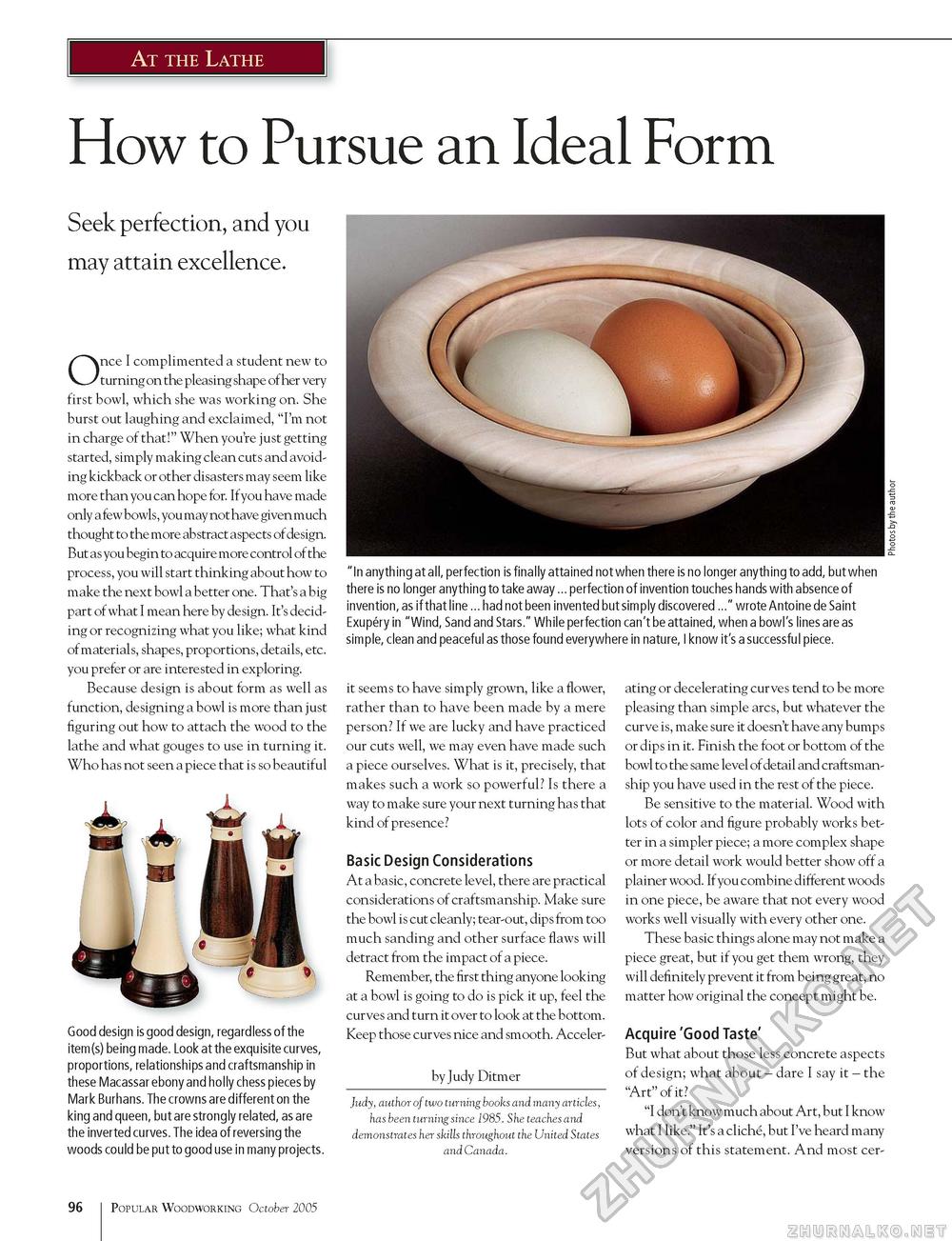Popular Woodworking 2005-10 № 150, страница 100
At the Lathe How to Pursue an Ideal Form Seek perfection, and you may attain excellence. Once I complimented a student new to turning on the pleasing shape of her very first bowl, which she was working on. She burst out laughing and exclaimed, "I'm not in charge of that!" When you're just getting started, simply making clean cuts and avoiding kickback or other disasters may seem like more than you can hope for. If you have made only a few bowls, you may not have given much thought to the more ab stract aspects of design. But as you begin to acquire more control of the process, you will start thinking about how to make the next bowl a better one. That's a big part of what I mean here by design. It's deciding or recognizing what you like; what kind of materials, shapes, proportions, details, etc. you prefer or are interested in exploring. Because design is about form as well as function, designing a bowl is more than just figuring out how to attach the wood to the lathe and what gouges to use in turning it. Who has not seen a piece that is so beautiful Good design is good design, regardless of the item(s) being made. Look at the exquisite curves, proportions, relationships and craftsmanship in these Macassar ebony and holly chess pieces by Mark Burhans. The crowns are different on the king and queen, but are strongly related, as are the inverted curves. The idea of reversing the woods could be put to good use in many projects. "In anything at all, perfection is finally attained not when there is no longer anything to add, but when there is no longer anything to take away ... perfection of invention touches hands with absence of invention, as if that line ... had not been invented but simply discovered ..." wrote Antoine de Saint Exupery in "Wind, Sand and Stars." While perfection can't be attained, when a bowl's lines are as simple, clean and peaceful as those found everywhere in nature, I know it's a successful piece. it seems to have simply grown, like a flower, rather than to have been made by a mere person? If we are lucky and have practiced our cuts well, we may even have made such a piece ourselves. What is it, precisely, that makes such a work so powerful? Is there a way to make sure your next turning has that kind of presence? Basic Design Considerations At a basic, concrete level, there are practical considerations of craftsmanship. Make sure the bowl is cut cleanly; tear-out, dips from too much sanding and other surface flaws will detract from the impact of a piece. Remember, the first thing anyone looking at a bowl is going to do is pick it up, feel the curves and turn it over to look at the bottom. Keep those curves nice and smooth. Acceler- by Judy Ditmer Judy, author of two turning books and many articles, has been turning since 1985. She teaches and demonstrates her skills throughout the United States and Canada. ating or decelerating curves tend to be more pleasing than simple arcs, but whatever the curve is, make sure it doesn't have any bumps or dips in it. Finish the foot or bottom of the bowl to the same level of detail and craftsmanship you have used in the rest of the piece. Be sensitive to the material. Wood with lots of color and figure probably works better in a simpler piece; a more complex shape or more detail work would better show off a plainer wood. If you combine different woods in one piece, be aware that not every wood works well visually with every other one. These basic things alone may not make a piece great, but if you get them wrong, they will definitely prevent it from being great, no matter how original the concept might be. Acquire 'Good Taste' But what about those less concrete aspects of design; what about - dare I say it - the "Art" of it? "I don't know much about Art, but I know what I like." It's a cliche, but I've heard many versions of this statement. And most cer 96 Popular Woodworking October 2005 |








